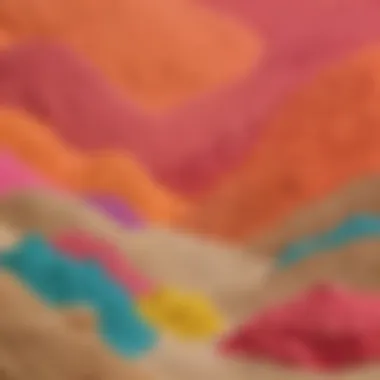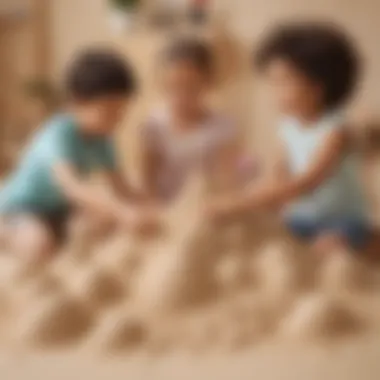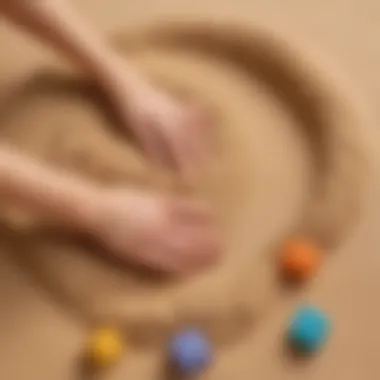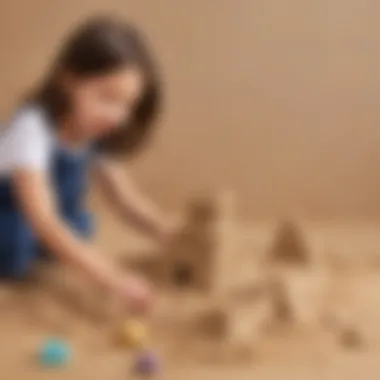Exploring Kinetic Sand: A Comprehensive Guide


Intro
Kinetic sand, a unique and versatile material, has captured the hearts and imaginations of children and adults alike. Unlike traditional sand, kinetic sand is engineered to adhere to itself, making it perfect for countless creative and educational activities. This tactile substance offers an enriching experience that stimulates children's senses and encourages imaginative play.
In this article, we will explore various aspects of kinetic sand, from its enticing properties to its practical uses. This guide will not only showcase the educational benefits of kinetic sand but also emphasize its therapeutic potential. Safety considerations and engaging play activities will be highlighted throughout, providing valuable insights for parents, educators, and caregivers who want to foster an engaging learning environment for children.
By demystifying the allure of kinetic sand, we aim to illustrate its significance in childhood development while offering a treasure trove of fun and educational ideas.
Prolusion to Kinetic Sand
Kinetic sand is more than just a colorful compound; it’s a playground for the senses and a powerful tool in early childhood development. Many parents and educators are discovering its numerous benefits, from enhancing fine motor skills to promoting imaginative play. This section will uncover what makes kinetic sand special and why it holds a valuable place in the learning landscape for children.
What is Kinetic Sand?
Kinetic sand is a unique substance composed mainly of sand and a polymer called polydimethylsiloxane. This combination gives it a distinctly moldable property—one that enables it to hold its shape while easily flowing through one’s fingers. You might compare it to traditional sand but with a twist; think of it as something like a cross between regular sand and dough. It’s often marketed as “sand that moves” or “sand that doesn’t make a mess,” a fact that appeals to parents looking to avoid clean-up nightmares. Kinetic sand doesn't dry out; it retains its pliable nature and can be reused endlessly, making it a cost-efficient option.
The Science Behind Kinetic Sand
At first glance, it can appear as if kinetic sand defies typical physics. The interplay of sand grains coated with the polymer allows for the unique tactile experience that many will find enjoyable and calming. The polymer coating creates friction which keeps the grains somewhat bound together, but not completely. This is why kinetic sand can be shaped into castles, flattened into patterns, or squeezed into tight forms only to return to its original texture when pulled apart. This engaging texture taps into sensory stimulation—children can both see and feel the sand moving in ways that standard sand cannot replicate.
Kinetic sand is not just a delight for tactile exploration; it’s supported by the principles of physics and chemistry that enhance a child's play experience, showcasing the enjoyable interplay between learning and fun.
In essence, kinetic sand presents a fascinating mingling of science and play. By understanding what kinetic sand is and how it works, caregivers can leverage its properties to create richer, more beneficial play experiences for children.
Properties of Kinetic Sand
When delving into the world of kinetic sand, one cannot overlook its striking properties. These characteristics not only set it apart from ordinary sand but also explain its growing popularity among children and adults alike. Understanding the properties of kinetic sand allows parents, educators, and caregivers to leverage its benefits effectively, fostering an engaging and safe play environment.
Unique Texture and Form
The first thing that strikes anyone about kinetic sand is its unique texture. Unlike conventional sand, which tends to be coarse and gritty, kinetic sand has a soft, silky feel. This distinct quality arises from its composition, primarily consisting of fine grains of sand that are coated with a polymer. This polymer gives kinetic sand a somewhat moldable characteristic, allowing it to stick together without the need for water. Children can form it into shapes, create sculptures, or simply enjoy the tactile sensation of running it through their fingers.
This tactile experience significantly enhances sensory play. Children who manipulate kinetic sand engage their sense of touch, which is crucial for sensory development.
- Subtle Movements: When kinetic sand is squeezed or compressed, it flows elegantly, mimicking the behavior of a fluid. This movement invites curiosity and experimentation, drawing kids in and keeping their attention for longer stretches.
- Resiliency: Unlike regular sand that can easily scatter and create a mess, kinetic sand tends to cling together and can be easily cleaned up. This makes it a favorite among parents who appreciate less cleanup with messy substances.
Non-Toxic Composition
Another significant aspect of kinetic sand is its non-toxic composition. It is vital for parents and educators to know that the materials used to create kinetic sand are safe for children. Typically, it is made from 98% sand and 2% polymer, which means no harsh chemicals are involved. This composition reassures caregivers, allowing them to focus on the educational and playful aspects without concern for safety.
It's not just about safety; the agreeable composition encourages more freedom while playing.
- Hypoallergenic Properties: Since many children have sensitivities or allergies, the non-toxic nature of kinetic sand serves as a worry-free option for inclusive play.
- Durability and Longevity: Due to its unique formulation, kinetic sand can be used multiple times without deteriorating or losing its appeal. One can store it, reuse it, and even mix it with other colors or items, making it a more sustainable choice when it comes to children’s toys.
"Kinetic sand's properties are not just about fun; they play a critical role in child development and learning through tactile experiences."
In summary, the properties of kinetic sand—its unique texture and non-toxic formulation—make it a pivotal tool in the arsenal of sensory play. Parents, caregivers, and educators can harness these attributes to cultivate a stimulating environment that promotes creativity, exploration, and development.


Uses of Kinetic Sand
The applications of kinetic sand extend far beyond mere playtime entertainment. Its intrinsic qualities offer a wealth of benefits that cater to various developmental stages and areas for children. Whether it’s helping with motor skills, providing therapeutic relief, or stimulating creative expression, kinetic sand serves multiple roles. This section will explore these aspects, highlighting the different uses of kinetic sand that make it an invaluable resource in both educational and recreational settings.
Therapeutic Benefits
Kinetic sand is more than just a fun material; it also provides numerous therapeutic benefits, particularly for children with special needs or those dealing with stress. Manipulating the sand can be quite soothing, almost like a form of tactile meditation. The soft, moldable nature of kinetic sand allows for endless shapes and forms, thereby promoting calming routines that can help reduce anxiety. For some, it can serve as a sensory tool that helps focus and ground them—integrating touch, sight, and sometimes even smell into the experience.
Research suggests that engaging with sand or similar tactile materials can aid in self-regulation, emotional expression, and overall well-being. The act of squeezing, rolling, or sculpting sand can distract from stressors and foster moments of creativity. So, whether you're crafting intricate castles or just letting your fingers glide through the grains, there's therapeutic merit in each session.
Artistic and Creative Applications
The creative potential of kinetic sand is significant and varied. It can serve as a blank canvas for the imagination. With it, kids can create everything from simple structures to elaborate landscapes. The textured surface allows children to experiment with shapes, colors, and forms, thus enhancing their artistic skills.
Consider, for instance, how kinetic sand mimics properties of both clay and traditional sand. It's easy to shape, and yet it holds form almost like a sculpture. This unique combination opens up possibilities for mixed media art projects, where kids can incorporate beads, small figures, or even natural elements like sticks and leaves to deepen their creations. This hands-on experience not only pushes the boundaries of conventional art but also encourages kids to think outside the box.
Educational Tools
In the realm of education, kinetic sand proves to be an effective tool for hands-on learning. Its versatility means it can be tailored to various subjects, from math to science, and beyond. Here are a few specific ways kinetic sand can be utilized:
- Math Skills: Children can use kinetic sand to explore basic geometric concepts by forming shapes, exploring symmetry, and understanding measurement through play.
- Science Exploration: Kids can learn about different properties of materials—like texture and weight—by experimenting with kinetic sand versus regular sand. It makes for an engaging environment to discuss concepts related to geology or the states of matter.
- Language Development: Simple activities involving kinetic sand, such as storytelling while shaping figures, can enhance vocabulary skills as children learn to describe their creations.
By integrating kinetic sand into the curriculum, teachers and caregivers add a practical, enjoyable component to learning that children are likely to remember. It encourages participation, sparks curiosity, and creates lasting memories.
"Playing with kinetic sand is not just play—it's a pathway to learning through exploration and creativity."
Kinetic Sand in Child Development
Kinetic sand is much more than a playful pastime; it’s a remarkable tool for fostering various aspects of child development. In this segment, we will explore how kinetic sand can enrich fine motor skills, stimulate sensory exploration, and encourage imagination and role play. The nature of this unique material makes it a valuable resource in early childhood education, providing both fun and learning opportunities in one package.
Enhancing Fine Motor Skills
Manipulating kinetic sand is an effective way for children to develop their fine motor skills. When kids dig, mold, and shape the sand, they engage in activities that strengthen their little fingers and hands. Consider the simple act of squeezing a handful of kinetic sand; this action itself requires a certain level of dexterity. As they practice manipulating the sand, children inadvertently enhance their grip strength and improve hand-eye coordination.
Moreover, children can engage in specific activities, like creating intricate shapes or building sandcastles, that challenge their dexterity even more. Using small tools like molds, scoops, or even their fingers allows them to navigate the sand with precision. This level of engagement is instrumental when it comes to tasks such as writing or buttoning a shirt as they grow older.
Stimulating Sensory Exploration
Kinetic sand provides a rich sensory experience, inviting children to explore textures, shapes, and even sounds. Its unique property of flowing and holding shape at the same time creates a tactile delight that can be both soothing and stimulating. When engaged with it, children can feel the grains slip between their fingers, experiencing the duality of softness and resistance.
For children who may have sensory processing issues, this material can serve as a gentle introduction to sensory play. The distinct texture of kinetic sand makes it ideal for those who may be hesitant with other sensory activities. Plus, since it's non-toxic, parents and caregivers can feel at ease knowing that it's safe for children to explore freely.
Encouraging Imagination and Role Play
Kinetic sand acts as a blank canvas for creativity. It offers children an opportunity to let their imaginations run wild. Whether they're crafting a small village, a dinosaur park, or a space scene, the possibilities are endless. This kind of imaginative play is crucial as it encourages kids to think outside the box, build narratives, and engage in social play when they collaborate with peers.
"Imaginative play is foundational for children to develop cognitive skills, and kinetic sand gives them the freedom to create their stories."
During these playful sessions, children also often engage in role play. By 'becoming' different characters—like a baker or an archaeologist while molding the sand—they practice social skills and develop an understanding of different roles in the world. It's a subtle way of teaching empathy and perspective-taking.


Safety Considerations
When it comes to play materials for children, ensuring safety is paramount. Kinetic sand, with its unique properties, provides a plethora of opportunities for sensory engagement and creativity. However, like all toys and materials, there are certain considerations that need careful attention. Understanding these safety considerations not only helps parents and educators to pick the right materials for children but also enhances the overall experience of playing with kinetic sand.
Age Appropriateness
Kinetic sand is generally deemed safe for various age groups, but age appropriateness plays a crucial role in guiding the use of this material. As a rule of thumb, kinetic sand is suitable for children aged three and older. Children under this age often put objects in their mouths, presenting a choking hazard with small particles.
Key points to consider for age appropriateness include:
- Supervision: For younger children, close supervision is needed to prevent accidental ingestion of the sand.
- Skill Development: Kinetic sand can foster fine motor skills and creativity in older children, while toddlers might only enjoy the tactile experience.
- Packaging: Always check the packaging for suggested age ranges and safety ratings before purchase.
Kinetic sand can also be a welcome addition to older children's play. It's versatile enough to be employed in various educational lessons, making it suitable for preschoolers and beyond. For young children, it can spark their imaginations, thus enhancing their learning and exploratory capabilities within safe guidelines.
Potential Allergens
While kinetic sand is mostly composed of non-toxic materials, awareness of potential allergens is vital for safeguarding children's health. Kinetic sand typically includes a mix of sand and a polymer that makes it moldable and less messy. However, some children might have allergic reactions to certain materials.
Important allergens to bear in mind include:
- Silica: While generally safe, fine dust from sand may cause respiratory irritation for those with preexisting conditions. It's advisable to choose brands that minimize this risk through their formulation.
- Coloring Agents: Some variations of kinetic sand contain dyes that can trigger allergies in sensitive individuals. Always verify if a child has known allergies to any components in the sand.
- Hygiene: Keep the sand clean and dry to prevent any potential mold or growth of bacteria, which could pose risks to health.
Always consult with a pediatrician if there are concerns regarding allergies or appropriate conditions for your child’s play materials.
Kinetic sand can be a safe, enjoyable learning tool if precautions are taken. Understanding age appropriateness and ingredient sensitivity ensures that children can explore their creativity and sensory experiences without unnecessary risk.
Activities to Explore with Kinetic Sand
Kinetic sand has gained popularity not just as a delightful play material but also as a versatile tool for education and creativity. Engaging with kinetic sand provides an array of benefits that extend beyond mere fun. It stimulates imaginations, enhances physical development, and encourages learning through play. Through various activities, both kids and adults can benefit from the therapeutic nature of this unique medium. This section explores multiple ways to utilize kinetic sand effectively, ensuring a rich sensory experience for children while nurturing their creativity.
Simple Play Ideas
When it comes to simple activities, the most fundamental ways to enjoy kinetic sand involve open-ended play. Here are a few ideas to kickstart the fun:
- Sand Castles: Encourage children to sculpt sand castles and fortresses. This not only enhances their fine motor skills but also promotes creativity as they decide how to decorate their structures.
- Animal Tracks: Use toy animals to make tracks in the sand. This activity not only lets kids play with different animal figures but also sparks discussions about the animals they create.
- Messages in the Sand: Children can use their fingers or small tools to write letters or numbers, promoting basic literacy and numeracy skills in a playful setting.
These simple activities can be done with minimal supervision and can be easily adapted based on a child's age or interests, making kinetic sand an ideal choice for all scenarios.
Creative Projects for Kids
Once they’ve conquered the basics, it’s time for kids to roll up their sleeves and dive into more creative projects. Such projects build on the open-ended aspects of play while enabling kids to experiment with more complex concepts:
- Color Mixing: Mix different colors of kinetic sand to create new shades. This hands-on experience introduces concepts of color theory while providing a visual treat.
- Themed Sets: Kids can create scenarios around themes such as underwater worlds or space. For instance, using blue kinetic sand for the ocean and adding toy sea creatures can bring their visions to life.
- Kinetic Sand Bakery: Baking might not be in the cards for every child, but they can enjoy a sand cake or cupcake workshop. Using molds, they can create their favorite desserts without the mess of actual cooking!
These creative endeavors push kids to think critically and foster an environment where original ideas are encouraged, making the experience much richer.
Incorporating Learning into Play


There's immense value in incorporating learning into playtime, turning kinetic sand into a multifunctional educational tool. Here are effective approaches to leverage the educational potential of kinetic sand:
- Science Explorations: Discuss the properties of sand while playing. This can lead to discussions about states of matter or even the concept of gravity as they watch the sand flow and shift.
- Math Manipulatives: Use kinetic sand to create simple math games. Kids can shape numbers and practice addition or subtraction using small objects like pebbles or toys as counters.
- Sensory Language Development: Describe the textures and shapes created in the sand. Words like "smooth," "squishy," or "grainy" enrich vocabulary while instilling a love for descriptive language.
By blending play with learning, children may not only enjoy their time but also absorb crucial concepts that will benefit them, now and in their future educational pursuits.
In summary, the activities that can be derived from kinetic sand are vast and versatile. This engaging material allows children to explore their creativity while simultaneously honing essential skills. It’s not just about playing; it's about growing, learning, and having a blast while doing so.
DIY Kinetic Sand Recipes
Creating your own kinetic sand at home can be a remarkable experience. It allows individuals, especially parents and caregivers, to engage more intimately with the play experience. Not only is this a more budget-friendly option, but it also fosters creativity and learning as children can observe and participate in the sand-making process. Moreover, DIY recipes provide an excellent opportunity for hands-on science exploration, linking playtime both to educational and sensory experiences.
Basic Homemade Kinetic Sand
Making basic homemade kinetic sand is surprisingly straightforward. All you need are a few ingredients to transform ordinary materials into something extraordinary. Here’s a simple recipe to get started:
Ingredients:
- 1 cup of sand
- 1/2 cup of cornstarch
- 1/2 cup of water
- 1 tablespoon of dish soap (optional for texture)
- Food coloring (optional for visual appeal)
Instructions:
- Start by mixing the sand and cornstarch in a large bowl, ensuring they blend thoroughly.
- In a separate container, mix the water and dish soap together. If you’re opting for food coloring, add it to this mixture.
- Gradually pour the water mixture into the dry mixture, stirring continuously until you reach a dough-like consistency.
- If your mixture is too dry, add a bit more water; if it's too wet, sprinkle in more sand.
- Once the desired texture is achieved, knead the sand in your hands for a few minutes.
This basic recipe can serve as a canvas for further experimentation. The resulting sands will have a satisfying texture that can hold shapes and engage little hands.
Variations Using Different Ingredients
Exploring variations can lead to enticing results, allowing for greater customization based on preferences and sensory needs. Here are some popular ideas:
- Add Oils or Gels: Incorporating baby oil or aloe vera gel can provide a smoother and softer texture, making the sand even more enjoyable to touch. The added shine can make the kinetic sand enticing and engaging.
- Flavored Variations: Using coconut or vanilla essence can introduce delightful aromas. This adds an exciting sensory layer, especially for younger children who thrive on sensory discovery.
- Colorful Layers: By dividing the basic sand into portions and adding different food colors, one can create vibrant, layered kinetic sand. Children can be instructed to mix the colors, enhancing their creativity and understanding of color blending.
- Thickening Agents: Alternative ingredients, such as shaving cream or flour, can be tried out for varied textures. Each agent can yield a different feel, and experimenting with these can teach kids about physical properties in a fun context.
"Though the process might seem messy, the joy of creation and the learning opportunities are both rewarding and meaningful for children and adults alike."
Regardless of the recipe chosen, the act of engaging with the materials introduces children to concepts of science and arts, while keeping playtime primarily focused on fun. Homemade kinetic sand opens up numerous avenues for parental involvement and educational interaction, proving to be valuable in both learning and leisure.
The End
The conclusion of this article plays a pivotal role in encapsulating the myriad benefits and insights surrounding kinetic sand. It serves as more than just a summary; it's a reflection on how this unusual substance influences children's play and learning.
The Lasting Impact of Kinetic Sand
Kinetic sand stands apart from standard play materials. Its unique composition will greatly contribute to childhood development, shaping skills and nurturing creativity.
When children play with kinetic sand, they are not just having fun; they are engaging in activities that bolster fine motor skills and stimulate their senses. The tactile sensation of the sand, the way it flows and molds effortlessly, captivates young minds and promotes exploratory behavior. This act of manipulation can significantly improve hand strength and dexterity, foundational abilities that are essential for tasks like writing and self-care.
"Kinetic sand is like a canvas for the imagination, allowing kids to build, sculpt, and create in ways that few other materials can."
Additionally, the versatility of kinetic sand provides endless possibilities for creative expression. Whether it's shaping figures, constructing intricate designs, or simply letting it flow between their fingers, children draw from their imaginations and expand their creative horizons.
In an educational context, kinetic sand acts as a catalyst for learning. It can be incorporated into lessons on science, art, and math, providing a hands-on approach that resonates deeply with the sensibilities of young learners. This dynamic tool enables educators to break down abstract concepts into tangible experiences, making learning both enjoyable and effective.
Moreover, the therapeutic benefits of kinetic sand cannot be understated. The act of playing with it can soothe anxiety and improve focus, making it a valuable resource in settings that require mindfulness and concentration.
In summary, kinetic sand is more than just a simple plaything; it has a profound impact on child development. Its ability to enhance fine motor skills, stimulate senses, and foster creativity is a testament to its value. As parents, educators, and guardians embrace this innovative material, they open the door to a world of engaging and enriching experiences for children.



